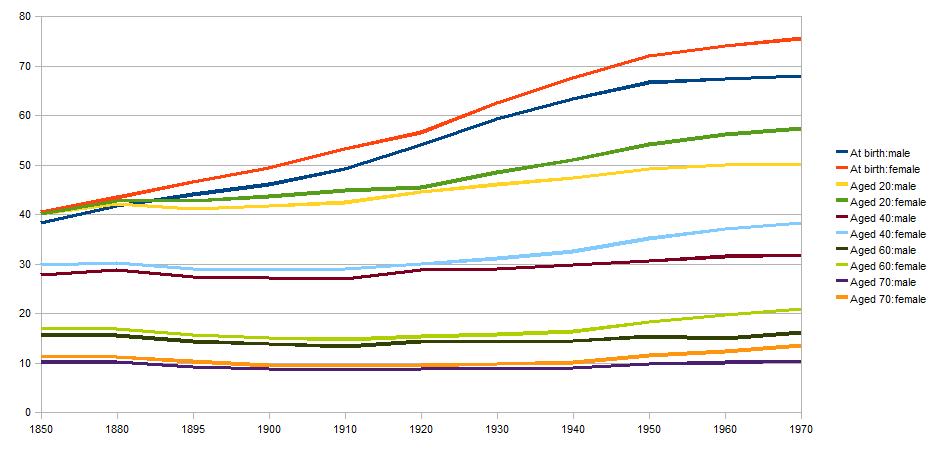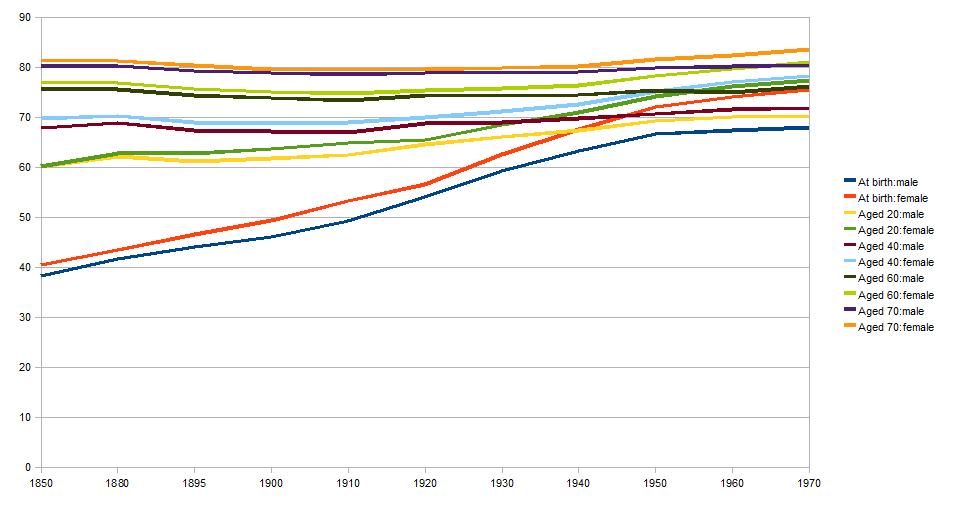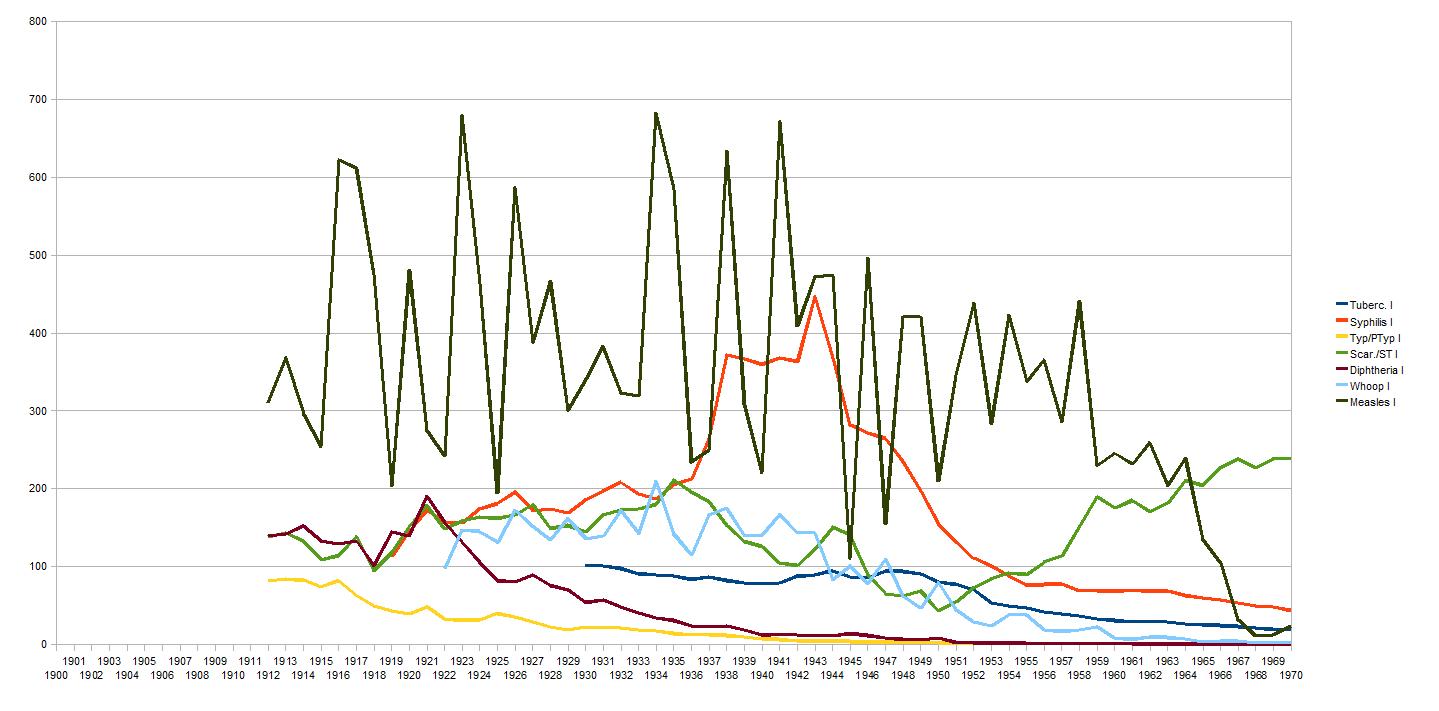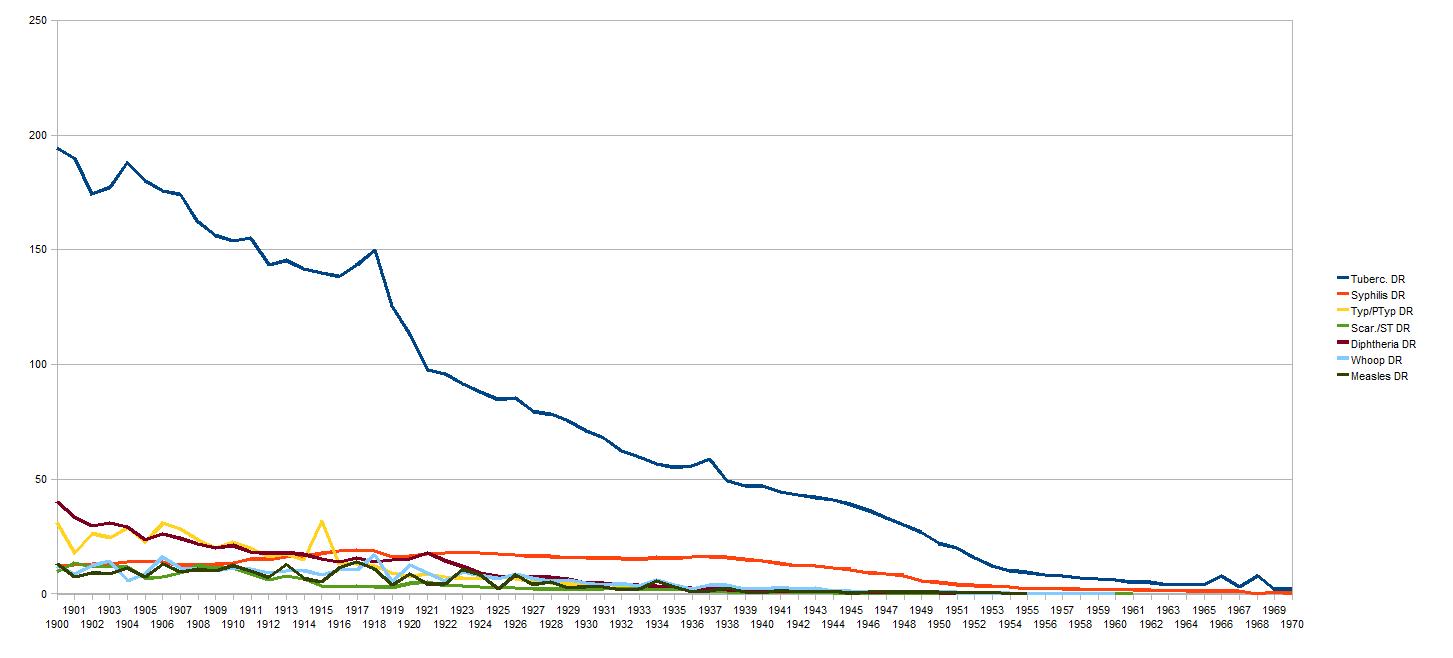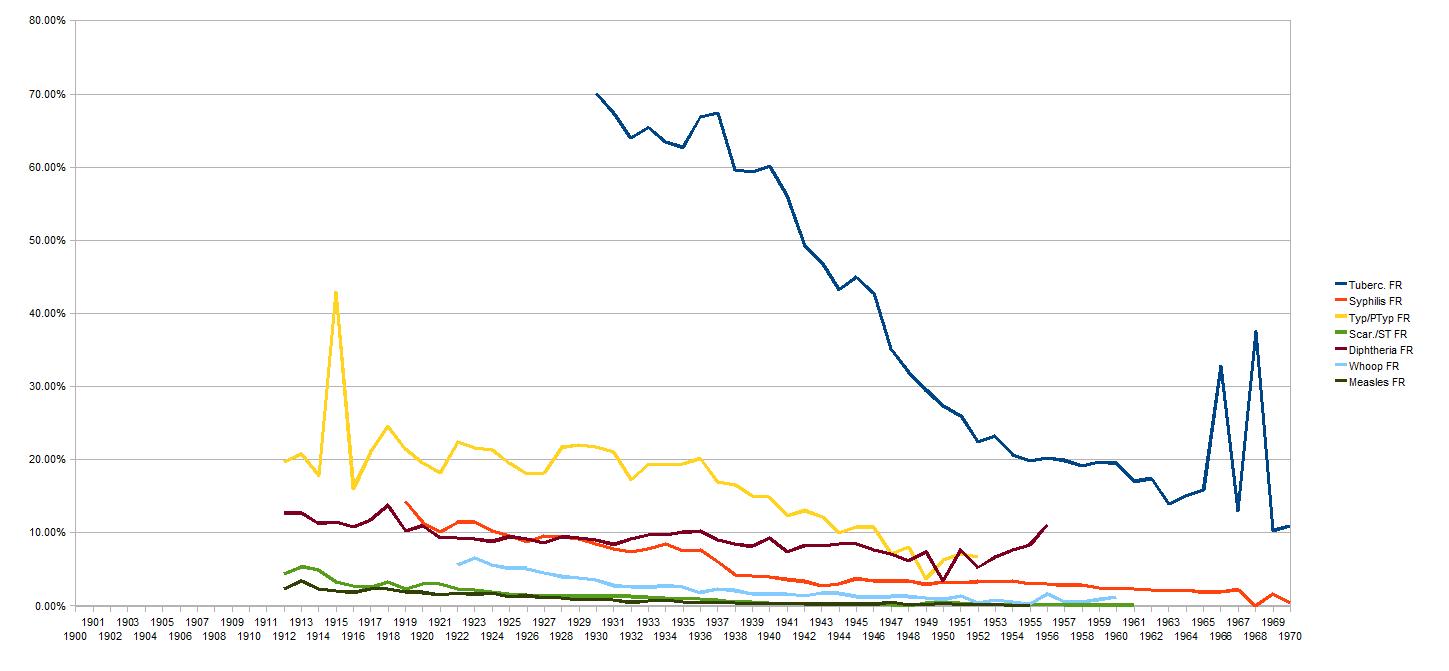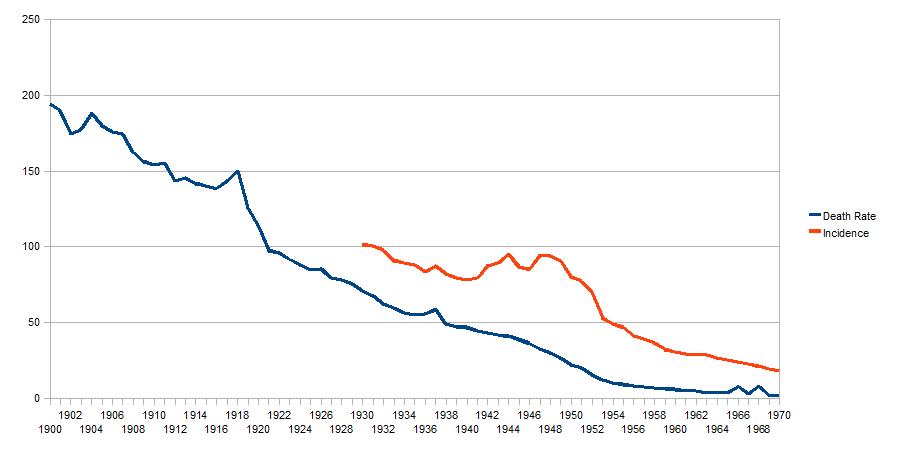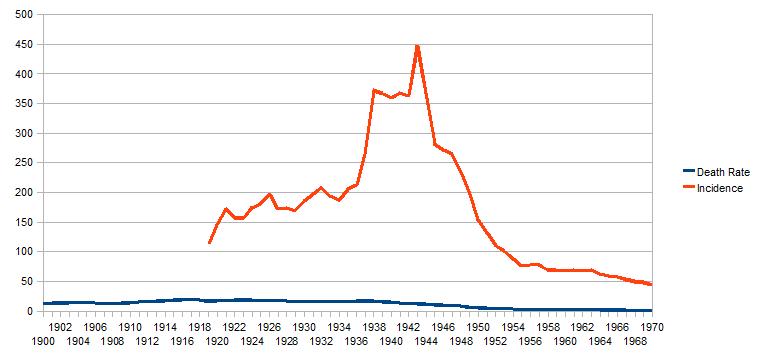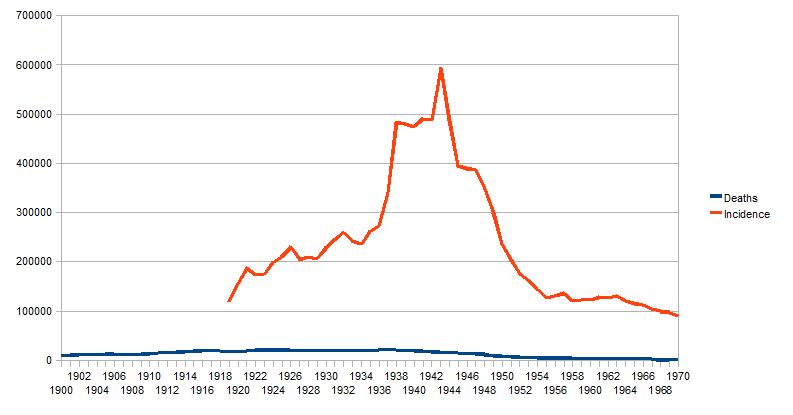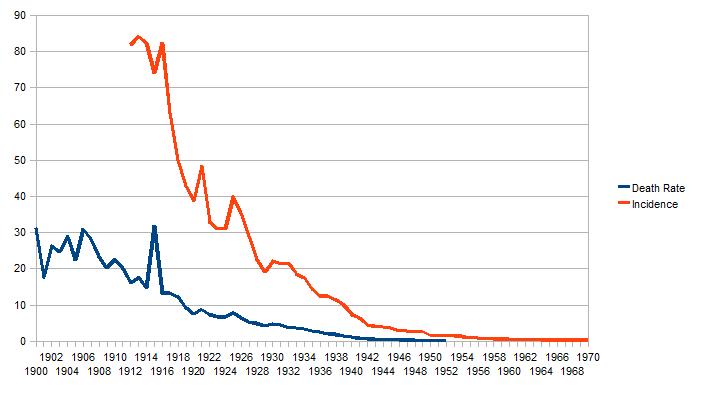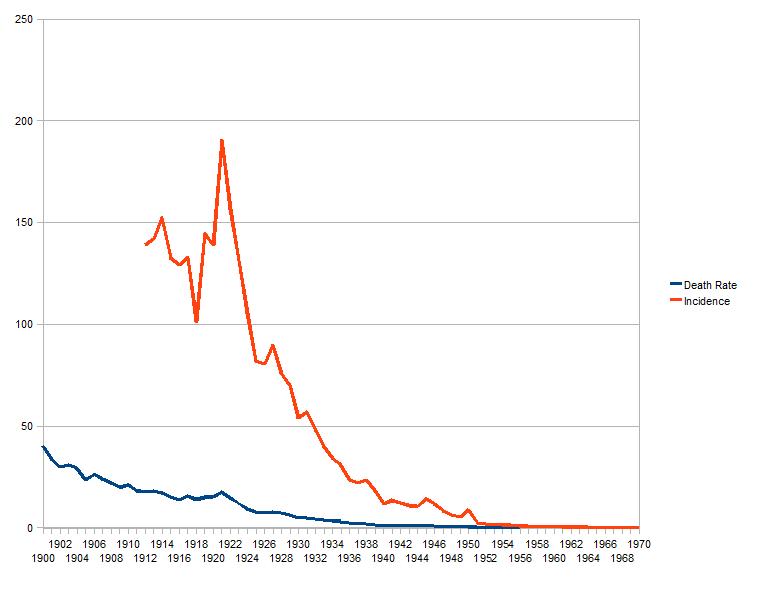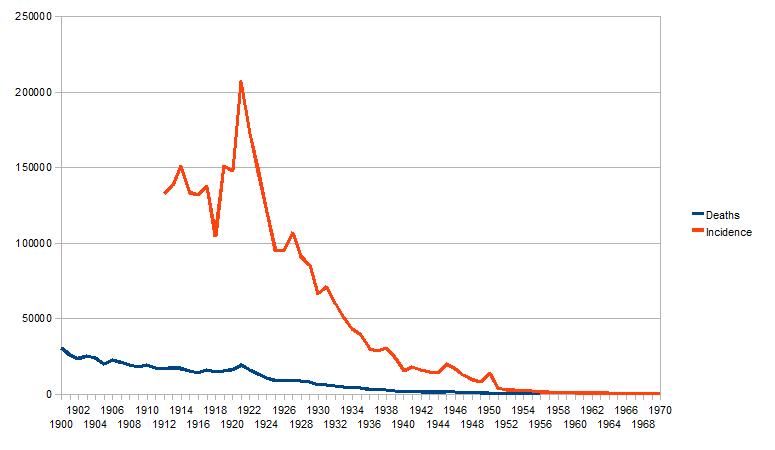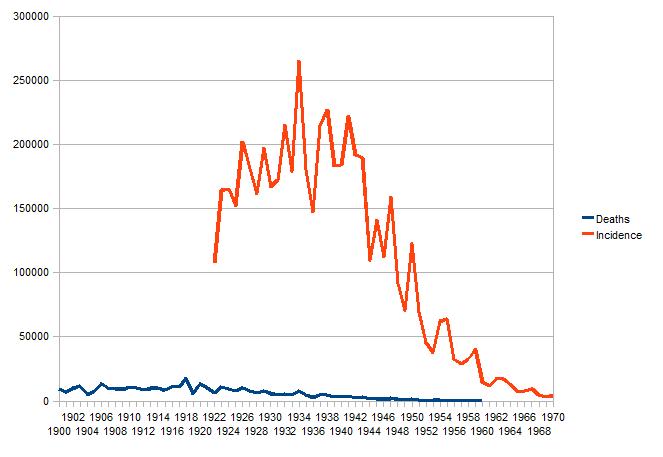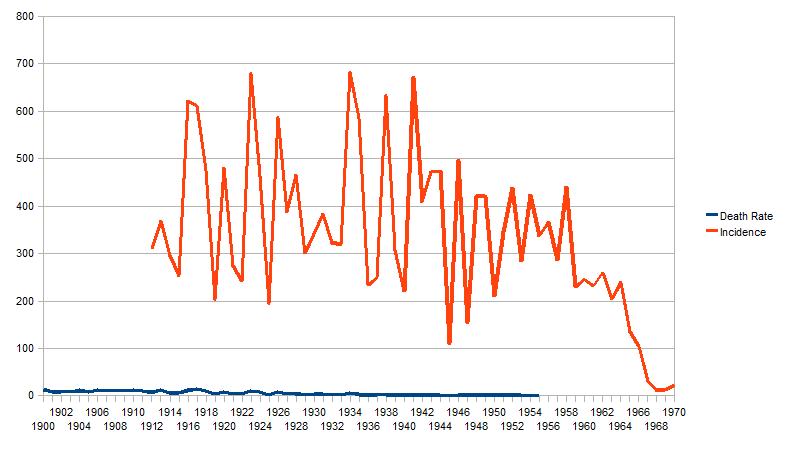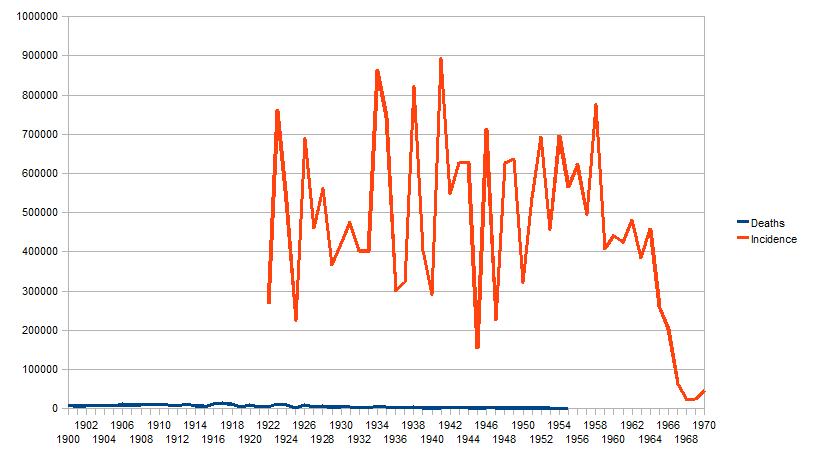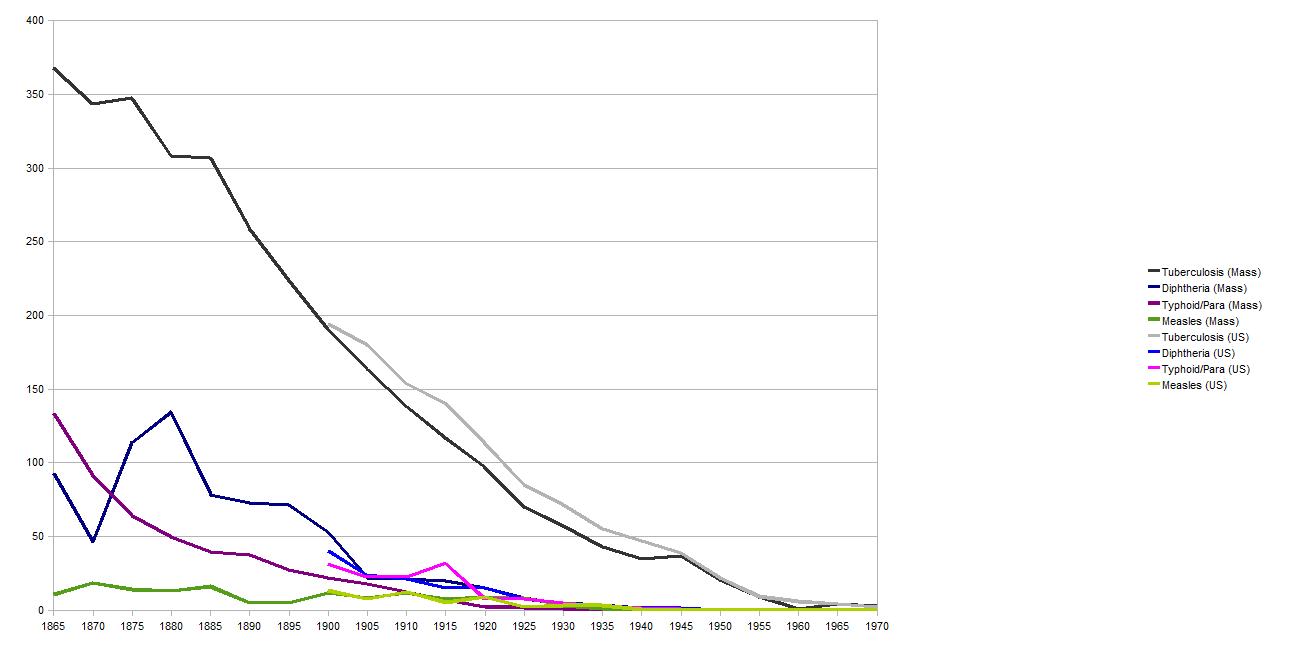It should be understood that those facing the greatest risk of deaths from infectious disease were neonates and young children. In the UK, in 1901, 36.2% of all deaths and 51.5% of childhood deaths were from infectious diseases. By contrast in 2000, 11.6% of all deaths and only 7.4% of childhood deaths were from infectious diseases. Infectious diseases were a significant cause of childhood mortality in British cities until about 40 years ago and the position in the US was unlikely to have been very different. Several factors, including vaccination, antibiotics and improved sanitation, have contributed to this trend.
ref: http://journals.cambridge.org/action/displayAbstract;jsessionid=85A27FF09D2D3D23CACC87A1AD380D0E.tomcat1?fromPage=online&aid=350203
"Improvements in hygiene habits were rooted in technological innovations and changed attitudes. From the early nineteenth through the mid-twentieth centuries, the gradual spread of municipal water and sewage systems and the growing availability of indoor plumbing, hot water heaters, washing machines, and commercially manufactured soaps - developments that extended outward from urban centres to small towns and rural regions, and down the social scale from the elite to the poor - marked a major transition in hygiene, making possible higher standards of personal cleanliness, less exhausting laundry procedures, and the sanitary disposal of human wastes.
By the 1920s, reformers concerned with immigrant assimilation successfully made cleanliness a hallmark of being "American." But it was the producers of hygiene products and household cleaning appliances, for whom cleanliness meant profits, who persuaded American consumers to accept nothing less than perfection, to look for "the cleanest clean possible." Incessant advertising appeals in magazines, on radio, and later on television created a culture of cleanliness that by the 1950s set Americans apart. With houses cleaner and bodies better groomed than ever before, cleanliness became an obsession. Dependence on daily showers, sensitivity to body odours, desire for immaculately clean houses, and preoccupation with teeth that gleamed distinguished Americans as a people."
The best indicator of improvements in sanitation and hygiene is typhoid fever. Sanitation and hygiene are critical to the prevention of typhoid. Typhoid does not affect animals and therefore transmission is only possible from human to human. Typhoid can only spread in environments where human faeces or urine are able to come into contact with food or drinking water.
An article in Health, a publication of the Water Quality & Health Council to the Chlorine Chemistry Division of the American Chemistry Council, entitled A Public Health Giant Step: Chlorination of U.S. Drinking Water reports on a recent study of disease rates in cities during the late 19th and early 20th centuries.
"A 2004 statistical study of disease rates in cities found clean water to be the reason for rapid declines in urban death rates during the late 19th and early 20th centuries. The study concludes that clean water was responsible for "nearly half of the total mortality reduction in major cities, three-quarters of the infant mortality reduction, and nearly two-thirds of the child mortality reduction." The study puts forth a striking finding - that chlorination and filtration reduced typhoid fever by 91% within 5 years, leading to its near-eradication by 1936."
The Massachusetts data confirms a falling death rate for typhoid fever throughout the second half of the nineteenth century which continued throughout the first half of the twentieth century. The US data confirms with an unchanging fatality rate that there had been little progress in the care and treatment of those who contracted this fearsome disease, at least until the introduction of antibiotics into clinical practise in 1942.
For example see The Real Truth: Vaccination Inefficacy in the Reduction/Elimination of Infectious Diseases by Roman Bystrianyk:
"The Vital Statistics of the United States contains compiled statistics for a wide variety of information since early in the 1900s. Among those are death rates from all diseases, including infectious diseases. An introductory statement from the 1937 statistics indicates that death rates from infectious diseases declined
greatly in the early part of the century. These declines occurred well before the advent of vaccines to treat these conditions.
The trend in death rates for specific causes, over the past 20 or 30 years, may be characterized by
two general statements. In the first place, there has been a great reduction in the death rates for
infectious and preventable diseases; in the second place, there has been an increase in the rates for
certain diseases characteristic of older ages. Greatest proportional rate decreases have taken place
for such diseases as typhoid and parathyroid fever, which has declined from a rate of 23.5 in 1910 to
2.1 in 1937; and diphtheria, which declined from a rate of 21.4 in 1910 to 2.0 in 1937. ... The rate
reductions for infectious and preventable diseases can be largely attributed to the development of
modern public-health practice.
From these figures, we can see that death rates from typhoid decreased by 91% from 1910 to 1937 and
death rates from diphtheria declined by 90.5% during the same time period. The decrease in diphtheria
occurred well before the use of vaccination."
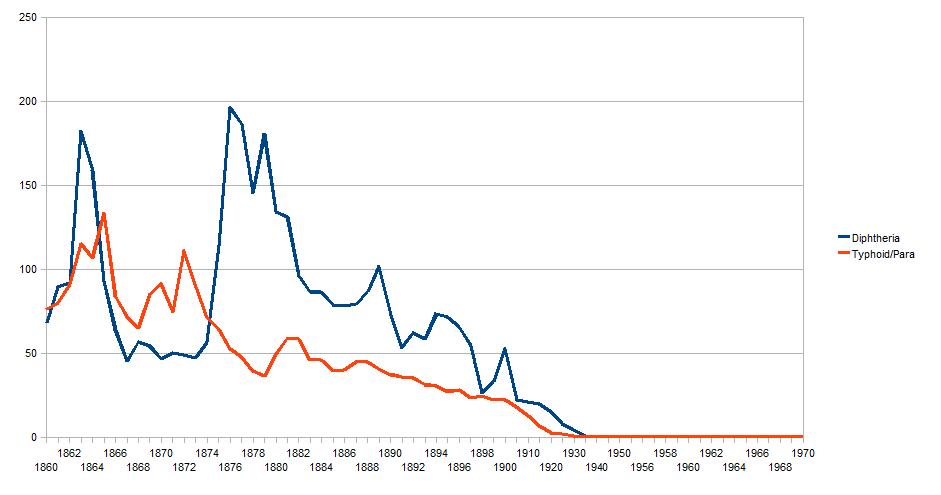
(i) Diphtheria is not caused by a water-borne pathogen; (ii) Massachusetts data shows that the reduction in deaths rates for typhoid fever and diphtheria follow only a generally common downward trend; (iii) for example, in Massachusetts, from 1870 to 1880 the typhoid fever death rate fell (from 91.5 to 49.5) while the diphtheria death rate increased (from 46.4 to 134.3); (iv) the fatality rate held steady at about 8% even after the introduction of vaccination (vaccination has no effect on the fatality rate); (vi) from 1920 the fall in the death rate parallels the fall in incidence. The data suggests strongly that the fall in the death rate from early 1920 was direct related to a fall in incidence which is the means by which vaccination reduces the death rate.
Pasteurization, the process of heating a liquid to below the boiling point to destroy microorganisms, was developed by Louis Pasteur in 1864 to improve the keeping qualities of wine. Common milk-borne illnesses during that time were typhoid fever, scarlet fever, septic sore throat, diphtheria, and diarrhoeal diseases. The commercial implementation of pasteurization, in combination with improved management practices on dairy farms, virutally eliminated milk as a source of these illnesses. In 1938, milk products were the source of 25% of all food and water-borne illnesses that were traced to sources, but now they account for far less than 1% of all food and waterborne illnesses.
Commercial pasteurization of milk began in the late 1800s in Europe and in the early 1900s in the United States. Pasteurization became mandatory for all milk sold within the city of Chicago in 1908, and in 1947 Michigan became the first state to require that all milk for sale within the state be pasteurized. In 1924 the U.S. Public Health Service developed the Standard Milk Ordinance to assist states with voluntary pasteurization programmes.
[taken from History of Pasteurization]
There is no doubt that historically hygiene has played the greatest role in reducing the number of deaths from infectious diseases, and to measurable improvements in expectation of life and no one would deny this. But we are not trying to make a choice between two competing strategies, which is what opponents of vaccination would have us do. Even once all the benefits of modern hygiene were in place, infectious diseases continued to kill and, in considerably larger numbers, maim neonates and children. From the beginning of the twentieth century, advances in medical treatment and care improved survivability but at considerable emotional and financial cost to patients, their families and, where state-financed care was available, through taxation of the local community. If the most effective way of overcoming these multiple burdens was to reduce the incidence of infectious diseases then vaccination offered the best means of achieving it. Where possible, as in the case of smallpox, by this means, the disease might even be eradicated altogether.
An article by Dr. Pat Kendall entitled Nutrition Comes of Age in the 20th Century points out that nutrition, which was barely a science at the turn of the century, would bring great advances in the discovery of essential nutrients, their roles in preventing disease and the translation of this information into nutritional policy.
Food restrictions and shortages during World War I created the need to ensure we were providing for the nutritional requirements of our soldiers and workers. In 1917, the U.S. Department of Agriculture issued the first dietary recommendations based on five food groups. In 1924, iodine was added to salt to prevent goitre. With that change, the rate of goitre in Michigan, for example, quickly fell from 39 to 9 percent.
The great depression of the 30s led to the development of food relief and food commodity distribution programs, including school meal and nutrition education programs, and national food consumption surveys.
The 30s also saw continued growth in the incidence of pellagra. Commonly described as the 4D disease for diarrhea, dermatitis, dementia and death, pellagra was originally considered an infectious disease and reported as such in public records. Between 1906 and 1940 some 3 million cases and 100,000 deaths in the United States were attributed to pellagra. In 1937, researchers confirmed that pellagra was not an infectious disease caught from someone else, but the result of insufficient niacin in the diet. This led to the adoption of public policy to enrich all flour with niacin, along with iron, thiamin and riboflavin. By the end of the 1940s pellagra was a disease of the past.
The 1940s was a time of great interest in nutrition. Our country was again engaged in war, food was rationed and as many as 25 percent of those drafted into the military showed evidence of past or present malnutrition. A program to fortify milk with vitamin D was instituted, followed by a decline in the incidence of rickets.
The association between TB and malnutrition has long been known. TB makes malnutrition worse and malnutrition weakens immunity, thereby increasing the likelihood that latent TB will develop into active disease. Robert Lee writing about social conditions in nineteenth century Europe (A Companion to Nineteenth-century Europe (2006)) summarises the work of Mckeown and others on determinants of mortality change in England, Wales and other European countries: "The fall in tuberculosis mortality was already evident before 1851, but its downward trajectory was not the result of changing exposure levels, housing improvements, or sanitary reform, but was attributable to increased per capita food supply." He goes on, however, to discuss criticisms of this explanation which many have argued is too simplistic ignoring, as it does, psychological stress (due to over-crowding and poor housing), urbanisation, human agency (quarantine, cordons sanitaires, the development of modern hospitals following Lister's antiseptic principles) and the benefits accruing from the reduction in sanitation diseases (typhoid, cholera, malaria). Lee is also critical of the assumption that the factor leading to a fall in TB mortality rates were necessarily due to increased levels of nutrition. After all, the mortality rates due to TB were as high among the better-fed elite as among the nutritionally disadvantaged poor.
